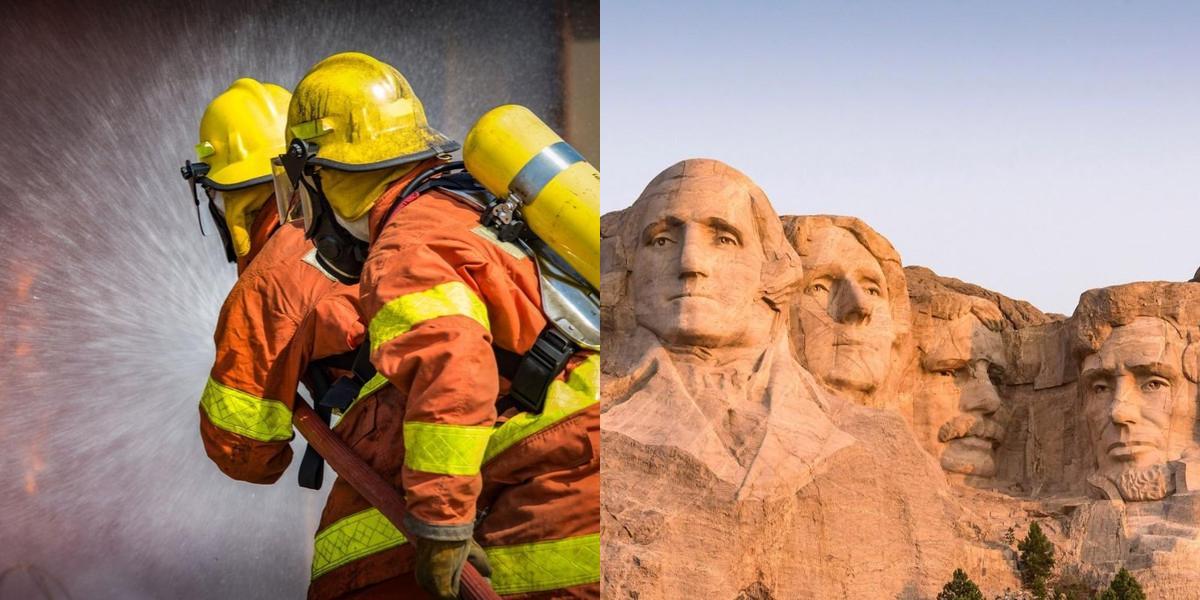How to Become a Firefighter in South Dakota (2025)

Firefighters play a crucial role in protecting lives and property by responding to various emergencies, including fires, accidents, and medical incidents. If you have a strong desire to serve your community and help others during times of crisis, becoming a firefighter may be the right career path for you. Here's a guide on how to become a firefighter in South Dakota.
How do I get a job as a Firefighter?
After obtaining your firefighter certification, the next step is to find a job as a firefighter. The process of getting a job as a firefighter can be competitive, as there are often many qualified candidates vying for a limited number of positions. However, with the right preparation and approach, you can increase your chances of landing a job as a firefighter. Here are some steps you can take:
-
Research Fire Departments: Start by researching the fire departments in your area or the area where you would like to work. Look for job postings and information about their hiring process. Some fire departments may require additional certifications or qualifications, so make sure you meet all the requirements before applying.
-
Prepare Your Resume: Create a professional resume that highlights your education, training, and any relevant experience you have. Include any certifications, awards, or special skills that may be relevant to the firefighting profession. Tailor your resume to the specific requirements of the fire department you are applying to.
-
Submit Your Application: Once you have identified a fire department you would like to work for, submit your application according to their instructions. This may involve filling out an online application form or sending in a physical application package. Make sure to include all the required documents, such as your resume, certifications, and references.
-
Prepare for the Interview: If your application is selected, you will be invited for an interview. Prepare for the interview by researching the fire department and familiarizing yourself with their mission, values, and operations. Practice answering common interview questions and be prepared to demonstrate your knowledge and skills related to firefighting.
-
Physical Ability Test: Many fire departments require candidates to pass a physical ability test as part of the hiring process. This test is designed to assess your physical fitness and ability to perform the tasks required of a firefighter. Practice the physical tasks that are commonly included in these tests, such as climbing stairs, lifting heavy objects, and carrying equipment.
-
Background Investigation: If you pass the interview and physical ability test, you will likely undergo a background investigation. This is to ensure that you have a clean criminal record and that there is nothing in your background that would disqualify you from working as a firefighter. Be prepared to provide any necessary documentation or information requested during this process.
-
Medical Examination: Before being hired as a firefighter, you will need to pass a medical examination. This is to ensure that you are in good health and physically capable of performing the duties of a firefighter. The medical examination may include a physical examination, drug screening, and other tests as required by the fire department.
-
Probationary Period: Once you are offered a job as a firefighter, you will typically be placed on a probationary period. This is a period of time, usually 6 to 12 months, during which your performance will be closely monitored. You will be expected to demonstrate your skills and abilities as a firefighter and follow all department policies and procedures.
By following these steps and being prepared for each stage of the hiring process, you can increase your chances of securing a job as a firefighter.
Career Paths and Opportunities after Becoming a Firefighter
Once you have become a certified firefighter and landed your first job, there are many opportunities for career growth and advancement in the firefighting profession. Here are some of the career paths and opportunities that you can explore:
-
Specialized Training: As a firefighter, you may have the opportunity to undergo specialized training in areas such as hazardous materials response, technical rescue, or wildland firefighting. This additional training can enhance your skills and open up new career opportunities within the fire service.
-
Promotion: Many fire departments have a structured promotional system that allows firefighters to advance in rank and responsibility. With experience and additional training, you can work your way up through the ranks, from firefighter to lieutenant, captain, battalion chief, and beyond. Each rank comes with increased responsibilities and leadership opportunities.
-
Specialized Roles: Fire departments often have specialized roles that firefighters can pursue. These roles may include positions in fire investigation, fire prevention, training and education, or emergency medical services. By specializing in a specific area, you can become an expert in that field and contribute to the overall effectiveness of the fire department.
-
Management and Administration: If you have strong leadership and organizational skills, you may be interested in pursuing a career in fire department management or administration. These roles involve overseeing the operations of the fire department, managing budgets, and developing policies and procedures. This career path may require additional education and training in management and leadership.
-
Teaching and Training: Many experienced firefighters go on to become fire service instructors or trainers. In this role, you would be responsible for teaching and training new recruits, as well as providing ongoing professional development for current firefighters. This is a rewarding career path that allows you to share your knowledge and experience with others.
-
Government and Consulting: Firefighters with extensive experience and expertise may find opportunities to work in government agencies or consulting firms. In these roles, you may be involved in developing fire codes and regulations, conducting fire safety inspections, or providing consulting services to businesses and organizations.
-
Volunteer and Community Service: Even if you are not pursuing a full-time career as a firefighter, you can still contribute to your community by volunteering as a firefighter. Many fire departments rely on volunteers to supplement their full-time staff. Volunteering as a firefighter allows you to gain valuable experience and make a difference in your community.
These are just a few examples of the career paths and opportunities that are available to firefighters. The firefighting profession offers a wide range of options for growth and advancement, allowing you to build a fulfilling and rewarding career.
How Much does a Firefighter Make?
The salary of a firefighter can vary based on factors such as location, experience, and the size of the fire department. According to the Bureau of Labor Statistics, the median annual wage for firefighters was $50,850 in May 2020. The lowest 10 percent earned less than $25,850, while the highest 10 percent earned more than $94,720.
For entry-level firefighters, the starting salary can be lower than the median wage. However, as they gain experience and move up the ranks, their salary can increase significantly. It's important to note that these figures are just averages, and the actual salary can vary depending on various factors.
Final Thoughts
Becoming a firefighter is a challenging and rewarding career choice. It requires dedication, physical fitness, and a strong commitment to serving others. By obtaining your firefighter certification and following the steps outlined in this article, you can increase your chances of landing a job as a firefighter and starting a fulfilling career in the fire service.
Remember to stay informed about the specific requirements and processes in your state or country, as they may vary from the information provided in this article. Research local fire departments and their hiring processes, and be prepared to invest time and effort into the application and interview process.
Once you have started your career as a firefighter, continue to seek opportunities for growth and advancement. Take advantage of specialized training, pursue leadership roles, and consider how you can contribute to the fire service in unique and meaningful ways.
Exploring different career paths? Dreambound offers in-depth guides to assist you in making well-informed decisions. Explore some of these resources below:

Winlynd Caballero is a member of Dreambound's Sales team. She helps in handling the company's finullcial transactions, generating reports, and school sales. Beyond her responsibilities in the realm of numbers and business, Winlynd finds herself deeply immersed in a world of art and music.



